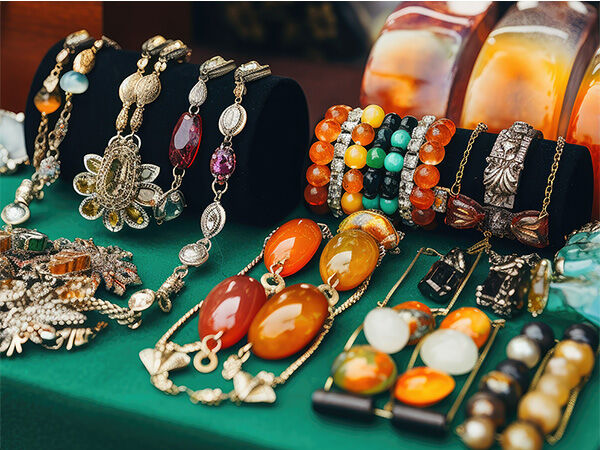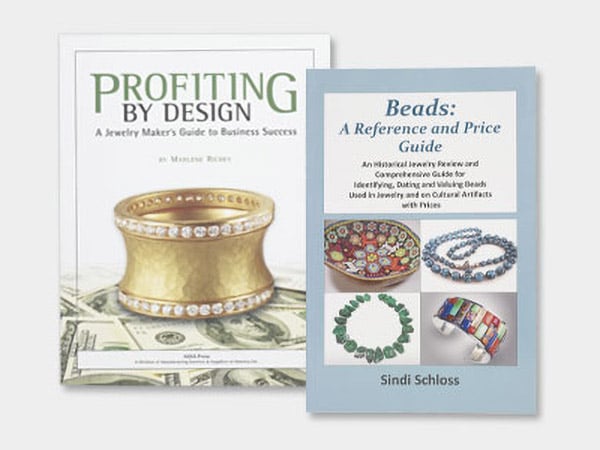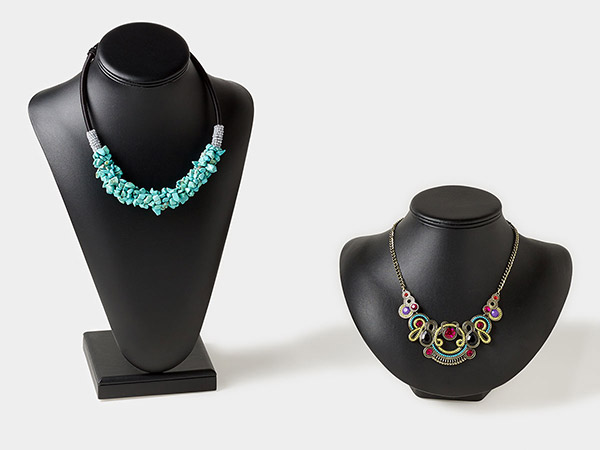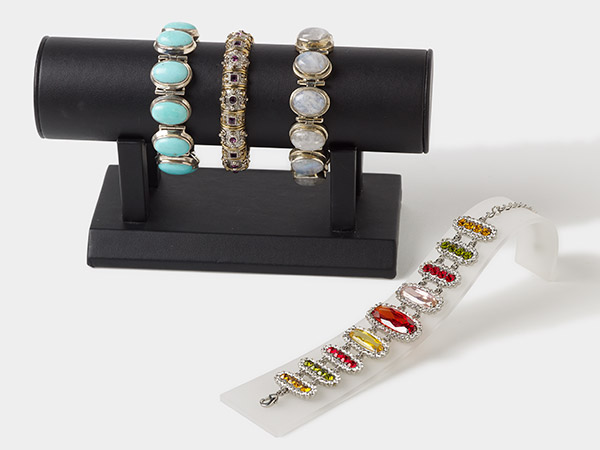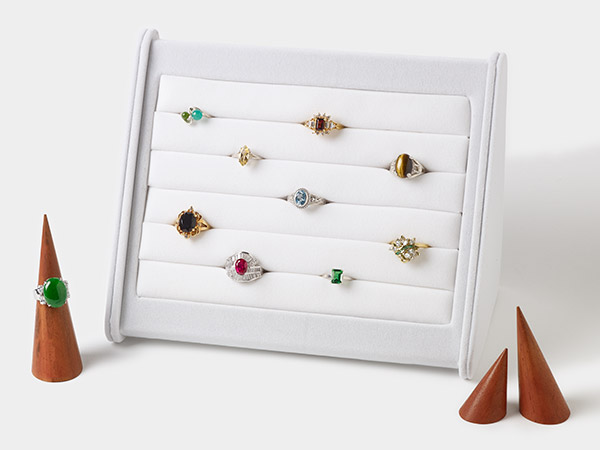How To Highlight Your Handmade Products
Displaying your products to the best advantage at art and craft shows can be a challenge. Because every artisan's products are unique--running the gamut from country crafts to jewelry to pottery to woodcrafts to oil paintings and everything in between--there is no one-sized-fits-all solution to how best to display your crafts.
Additionally, because art and craft shows are temporary, not permanent, your displays have to be reasonably portable, easy to assemble and disassemble, and lightweight enough that you don't need to enlist burly friends to help set up your booth.
To top things off, the average booth size is a modest 10 x 10 feet square, resulting in the challenge of displaying things in an attractive and eye-catching fashion while giving browsers enough space to look over the products without feeling cramped. Whew, what a challenge.
First Impressions
Your job is to make an instant and positive impression on passersby. When someone glances in your space, what do you want them to feel or think? Sleek and modern? Earthy and robust? Fresh and clean? Your booth and its displays should reflect the mood you want to set as well as showcase your products to advantage. The use of color, fabrics, and material (plastic, wood, velvet, chrome, metal) all set different tones. Choose carefully.
Five factors when displaying your products
- Organization
- Accessibility
- Space
- Visibility
- Protection
Display units can be pulled together in three ways
- Pre-made professional units
- Repurposing other materials
- Do-it-yourself alternatives
Think Vertical
Because of the small confines of most booths, vendors must get creative in displaying their products vertically rather than horizontally. Using walls, shelves, and hangings allow more of your products to be at eye-level for customers while giving enough floor space to walk without tripping.
Hang things whenever possible. This allows customers to touch and feel the product, enjoy the movement, but usually deters theft. Obviously extremely valuable and easily pocketed items such as jewelry may need extra protection.
In every case, the key ingredient is visibility. It may seem obvious, but if the customer doesn't see the product--and see it quickly--then it doesn't exist.
Professional Displays
Commercially made display units have advantages and disadvantages. The advantages are clear: excellent quality, unusual or creative designs, and specialty options that are difficult to duplicate. Displays can include freestanding, wall-mounted, or tabletop selections. They can be lockable, or glass-fronted, or geared for anything from bakery items to museum collectibles. Many are portable, designed to fold or collapse, and often movable on wheels.
The disadvantages for commercial displays are two-fold. One, they are expensive. Most artisans are understandably reluctant to drop anywhere from $50 to $5000 on high-quality professional units, at least until later in their careers when finances may not be as pinched. And two, they may not be suitable for your particular art or craft. Not every product can be shoehorned into every display unit.
If you just need a few items to round out your booth displays, such as collapsible bookcases or wire baskets, then large box stores (either online or brick-and-mortar) can often provide what you need. For both prices and ideas, it's worth looking over excellent online retailers specializing in displays.
Online Retailers
- Displays 2 go
- Décor Steals
- Super Z Outlets
- The Maine Bucket Company
- Store Supply Warehouse
The wide selection of products they offer make them well worth scanning. Keep in mind professional booth displays are not an all-or-nothing proposition. Many experienced vendors have a select few commercial displays for specialized items (lock-up cases for valuable jewelry, ring display hands, mannequin heads for hats, large or small easels to highlight a product sample, etc.) while the rest of their products are showcased with repurposed items or DIY projects.
Repurposing
Get creative when it comes to repurposing unusual items into display units for fun and frugal alternatives. Think outside the box. A large patio umbrella set up within your booth--even for indoor shows--allows you to dangle sample products from the struts (just make sure they won't smack your customers in the face). For extra sparkle, weave fairy lights among the arms.
Step ladders (especially wood ones) can be unfolded and boards set up on the rungs for display. Alternately, wicker or metal baskets can be inserted between the ladder rungs, angled outward for easy viewing. This is especially suited to large quantities of similar items, such as different scented soaps or folded linens.
To display smaller items, some enterprising souls use vintage suitcases propped up on their sides with thin shelves inserted inside. Others use old cassette boxes, picnic baskets, or other storage cases that can be propped open. If there is room in your booth, narrow dressers with drawers filled with products might be an option (which also allows for surface displays as well).
Crates and pallets have endless display possibilities. Crates can be used as building blocks for customized display (make sure they're secure so they don't topple down on customers, especially children). Pallets, with their built-in slats, are idea for draping linens or other flexible items.
Do-It-Yourself Options
If you're handy at DIY projects--and many artisans are--then another frugal alternative is to scope out attractive displays (either online or among fellow vendors) and then customize those display options for your own use. Think "lightweight" when it comes to showing your products. Chicken wire, canvas, burlap, linens, thin plywood--these are all popular materials from which to create displays.
For showcasing hangable items, folding panels (either stand-alone or tabletop) made of hinged wooden frames and chicken wire centers are versatile and easy to make. For lightweight shelving units in a similar style, wooden hinged foldable frames with thin boards for shelves are easy to set up and adjust.
Similarly, tabletop or stand-alone wooden "trees" are excellent and portable options for displaying anything that dangles (with the added advantage the products are likely to move in a breeze, catching the eye of passersby).
Sometimes DIY display units can be even easier, such as stackable wooden crates (which can then be packed with products at the end of the show). In all cases, whenever something is stacked, make sure it's sturdy enough not to fall on a customer because of windy conditions, a light bump, or curious children.
Do's and Don'ts For Displays
Make sure your booth doesn't flow into the booth next to you. Small half-walls (easily made from PVC rods draped with fabric) or other visual barriers will allow you to customize your own space.
Do a "100-foot test." Stand well back from your booth--as much as 100 feet--and gauge the impression it makes. Does it get swallowed up? Is it dark and dingy? Can you guess what it sells? Is your signage adequate?
Arts and crafts shows are not the place to leave customers guessing about prices. Make sure prices are conspicuously visible. If a customer must ask the price, you've probably already lost a sale.
Vary the height of your displays. It's natural for customers to scan a booth in a "wave" pattern (up and down, side to side). If your displays conform to this natural tendency, customers will see more of your products. This is why vertical displays are superior to flat tabletop displays.
Don't sit. Or at least, sit in a high director's chair, which puts you at eye-level for customers. A sitting vendor, particularly one who is staring at a smart phone, implies a vendor is not interested in interacting with customers.
Cut the clutter. Extra stock or storage boxes should be out of sight. Displayed items should be grouped attractively, but not so densely that customers gloss over them.
Use all your space. Even "blank" spaces can have something colorful or interesting on the walls directing customers' attention to your products. Dangle things from above--close to the edges of your booth, so customers won't bump into them.
Think like a buyer. What would make a customer's experience more convenient? Would a mirror help them select a purchase? Most customers don't like asking questions, so what up-front information (prices, sizes) can you provide for their convenience?
Leave Room For Yourself
In the exuberance that comes with designing a handsome, attractive booth space, don't forget to leave room for yourself. After all, the booth will be your home away from home for anywhere from one to five days. You'll need a space to process payments, store extra stock, stash your lunch, keep valuables (purse, wallet, electronics), or have a moment's privacy.
If you can curtain off a small corner or back portion of the booth, this creates a tiny room for storage--make sure this area is secured against grab-and-dash theft. At the very least, leave a square of table space for processing financial transactions.
As you can gather, selling venues are something of a science. By incorporating a few tried-and-true tactics with your own creative twists, you can expect improved sales.
Have a question regarding this project? Email Customer Service.
Copyright Permissions
All works of authorship (articles, videos, tutorials and other creative works) are from the Fire Mountain Gems and Beads® Collection, and permission to copy is granted for non-commercial educational purposes only. All other reproduction requires written permission. For more information, please email copyrightpermission@firemtn.com.
